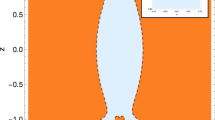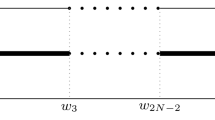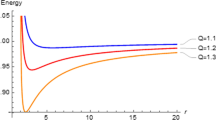Abstract
An exact solution of two singularities in the teleparallel equivalent to general relativity theory has been obtained. A holographic visualization of the binary black holes (BBHs) space-time, due to the non vanishing torsion scalar field, has been given. The acceleration tensor of BBHs space-time has been calculated. The results identify the repulsive gravity zones of the BBHs field. The total conserved quantities of the BBHs has been evaluated. Possible gravitational radiation emission by the system has been calculated without assuming a weak field initial data.



Similar content being viewed by others
Notes
The Greek indices describe the components of tangent space to the manifold (space-time), while the Latin ones describe the components of the space-time.
It is worth mentioning that the so called Kretschmann scalar is just \(8W1R\) in this space (Abdelqader and Lake 2012).
References
Abdelqader, M., Lake, K.: Phys. Rev. D 86(12), 124037 (2012). 1207.5496. doi:10.1103/PhysRevD.86.124037
Arianrhod, R., Fletcher, S., McIntosh, C.B.G.: Class. Quantum Gravity 8(8), 1519 (1991)
Bamba, K., Shimizu, K.: Int. J. Geom. Methods Mod. Phys. (2015). 1506.02760. doi:10.1142/S0219887816500018
Blagojevic, M., Vasilic, M.: Class. Quantum Gravity 5, 1241 (1988). doi:10.1088/0264-9381/5/9/009
Botta Cantcheff, M.: Phys. Rev. D 78(2), 025002 (2008). 0801.0067. doi:10.1103/PhysRevD.78.025002
Capozziello, S., González, P.A., Saridakis, E.N., Vásquez, Y.: J. High Energy Phys. 2, 39 (2013). 1210.1098. doi:10.1007/JHEP02(2013)039
Cooperstock, F.I.: Phys. Rev. D 10, 3171 (1974). doi:10.1103/PhysRevD.10.3171
Cooperstock, F.I.: Gen. Relativ. Gravit. 6, 91 (1975). doi:10.1007/BF00766607
Cooperstock, F.I.: Phys. Rev. D 25, 3126 (1982). doi:10.1103/PhysRevD.25.3126
Cooperstock, F.I., Hobill, D.W.: Phys. Rev. D 20, 2995 (1979). doi:10.1103/PhysRevD.20.2995
Cooperstock, F.I., Lim, P.H.: Phys. Rev. D 15, 2105 (1977). doi:10.1103/PhysRevD.15.2105
Cooperstock, F.I., Lim, P.H.: Astrophys. J. 304, 671 (1986). doi:10.1086/164205
Curzon, H.E.J.: Proc. Lond. Math. Soc. 23, 477 (1924)
de Felice, F.: Gen. Relativ. Gravit. 23(2), 135 (1991). doi:10.1007/BF00772611
Dietz, W., Hoenselaers, C.: Phys. Rev. Lett. 48, 778 (1982). doi:10.1103/PhysRevLett.48.778
Einstein, A., Rosen, N.: Phys. Rev. 49, 404 (1936). doi:10.1103/PhysRev.49.404.2
El Hanafy, W., Nashed, G.G.L.: Eur. Phys. J. C 75(6), 279 (2015). arXiv:1409.7199 [hep-th]. doi:10.1140/epjc/s10052-015-3501-y
Ghosal, S.K., Nandi, K.K.: Phys. Lett. A 119(9), 435 (1987). doi:10.1016/0375-9601(87)90410-5
Hayashi, K.: Phys. Lett. B 69, 441 (1977). doi:10.1016/0370-2693(77)90840-1
Hayashi, K., Shirafuji, T.: Phys. Rev. D 19, 3524 (1979). doi:10.1103/PhysRevD.19.3524
Hehl, F.W., McCrea, J.D., Mielke, E.W., Ne’eman, Y.: Phys. Rev. D 258, 1 (1995). gr-qc/9402012. doi:10.1016/0370-1573(94)00111-F
Hulse, R.A., Taylor, J.H.: Astrophys. J. 195, 51 (1975). doi:10.1086/181708
Jackiw, R., Pi, S.-Y.: Phys. Rev. D 68(10), 104012 (2003). gr-qc/0308071. doi:10.1103/PhysRevD.68.104012
Katz, A.: J. Math. Phys. 9, 983 (1968). doi:10.1063/1.1664691
Kawai, T.: Phys. Rev. D 62(10), 104014 (2000). gr-qc/0007081. doi:10.1103/PhysRevD.62.104014
Kawai, T., Shibata, K., Tanaka, I.: Prog. Theor. Phys. 104, 505 (2000). gr-qc/0007025. doi:10.1143/PTP.104.505
Krššák, M., Saridakis, E.N.: ArXiv e-prints (2015). 1510.08432
Letelier, P.S., Oliveira, S.R.: Class. Quantum Gravity 5(2) (1988)
Letelier, P.S., Oliveira, S.R.: Class. Quantum Gravity, 421 (1998)
Li, B., Sotiriou, T.P., Barrow, J.D.: Phys. Rev. D 83(6), 064035 (2011). arXiv:1010.1041 [gr-qc]. doi:10.1103/PhysRevD.83.064035
Linet, B.: Gen. Relativ. Gravit. 17(11), 1109 (1985). doi:10.1007/BF00774211
Lucas, T.G., Obukhov, Y.N., Pereira, J.G.: Phys. Rev. D 80(6), 064043 (2009). 0909.2418. doi:10.1103/PhysRevD.80.064043
Maluf, J.W.: J. Math. Phys. 35, 335 (1994). doi:10.1063/1.530774
Maluf, J.W.: Ann. Phys. 525, 339 (2013). arXiv:1303.3897 [gr-qc]. doi:10.1002/andp.201200272
Maluf, J.W.: Gen. Relativ. Gravit. 46, 1734 (2014). doi:10.1007/s10714-014-1734-y
Maluf, J.W., Ulhoa, S.C., da Rocha-Neto, J.F.: ArXiv e-prints (2012). 1201.6392
Maluf, J.W., da Rocha-Neto, J.F., Torìbio, T.M., Castello-Branco, K.H.: Phys. Rev. D 65(12), 124001 (2002). gr-qc/0204035. doi:10.1103/PhysRevD.65.124001
Nashed, G.G.L.: Int. J. Mod. Phys. A 21, 3181 (2006). gr-qc/0501002. doi:10.1142/S0217751X06031478
Nashed, G.G.L.: Eur. Phys. J. C 49, 851 (2007). 0706.0260. doi:10.1140/epjc/s10052-006-0154-x
Nashed, G.G.L.: Int. J. Mod. Phys. A 25, 2883 (2010a). 1004.1771. doi:10.1142/S0217751X10049037
Nashed, G.G.L.: Astrophys. Space Sci. 330, 173 (2010b). 1503.01379. doi:10.1007/s10509-010-0375-1
Nieh, H.T.: Int. J. Mod. Phys. A 22, 5237 (2007). doi:10.1142/S0217751X07038414
Obukhov, Y.N., Pereira, J.G.: Phys. Rev. D 69(12), 128502 (2004). gr-qc/0406015. doi:10.1103/PhysRevD.69.128502
Obukhov, Y.N., Rubilar, G.F., Pereira, J.G.: Phys. Rev. D 74(10), 104007 (2006). gr-qc/0610092. doi:10.1103/PhysRevD.74.104007
Schleifer, N.: Phys. Lett. A 112, 204 (1985). doi:10.1016/0375-9601(85)90503-1
Shapiro, S.L., Teukolsky, S.A.: Black Holes, White Dwarfs and Neutron Stars: the Physics of Compact Objects, p. 477. Wiley-VCH, Weinheim (1986). Chap. 16
Shirafuji, T., Nashed, G.G.: Prog. Theor. Phys. 98, 1355 (1997). gr-qc/9711010. doi:10.1143/PTP.98.1355
Shirafuji, T., Nashed, G.G., Hayashi, K.: Prog. Theor. Phys. 95, 665 (1996). gr-qc/9601044. doi:10.1143/PTP.95.665
Silberstein, L.: Phys. Rev. 49, 268 (1936). doi:10.1103/PhysRev.49.268
Sotiriou, T.P., Li, B., Barrow, J.D.: Phys. Rev. D 83(10), 104030 (2011). arXiv:1012.4039 [gr-qc]. doi:10.1103/PhysRevD.83.104030
Szekeres, P., Morgan, F.H.: Commun. Math. Phys. 32(4), 313 (1973). doi:10.1007/BF01645612
Wanas, M.I., Awadalla, N.S., El Hanafy, W.S.: ArXiv e-prints (2010). 1002.3399
Weitzenbök, R.: Invarianten Theorie. Noordhoff, Gröningen (1923)
Acknowledgements
Acknowledgments This article is partially supported by the Egyptian Ministry of Scientific Research under project No. 24-2-12.
Author information
Authors and Affiliations
Corresponding author
Appendix: Notation
Appendix: Notation
As is known, the exterior product is indicated by ∧, however the interior product of a vector \(\xi\) and a p-form \(\varPsi\) is indicated by \(\xi \rfloor\varPsi\). The vector basis dual to the frame 1-forms \(\vartheta^{\alpha}\) is indicated by \(e_{\alpha}\) and they fulfil \(e_{\alpha}\rfloor\vartheta^{\beta}={\delta}_{\alpha}^{\beta}\). By using local coordinates \(x^{i}\), we get \(\vartheta^{\alpha}=h^{\alpha}_{i} dx^{i}\) and \(e_{\alpha}=h^{i}_{\alpha}\partial_{i}\) with \(h^{\alpha}_{i}\) and \(h^{i}_{\alpha}\) are the covariant and contravariant components of the tetrad field. The volume 4-form is defined by \(\eta\stackrel{\mathrm{def.}}{=} \vartheta^{\hat{0}}\wedge\vartheta^{\hat{1}}\wedge \vartheta^{\hat{2}}\wedge\vartheta^{\hat{3}}\). Additionally, by using the interior product we define
with \(\epsilon_{\alpha\beta\gamma\delta}\) is completely antisymmetric tensor and \(\epsilon_{0123}=1\)
that are the bases for 3-, 2- and 1-forms respectively. Finally,
is the Levi-Civita tensor density. The \(\eta\)-forms fulfil the following useful identities:
The line element \(ds^{2} := g_{\alpha\beta} \vartheta^{\alpha}\bigotimes\vartheta^{\beta}\) is fulfil by the space-time metric \(g_{\alpha\beta}\).
One can consider teleparallel geometry as a gauge theory of translation (Hehl et al. 1995; Hayashi 1977; Hayashi and Shirafuji 1979; Obukhov et al. 2006; Nashed 2010a). In such geometry the coframe \(\vartheta^{\alpha}\) plays the role of the gauge translational potential of the gravitational field. General relativity can be reconstructed as the teleparallel theory. From geometric viewpoint, teleparallel gravity can be regarded as a particular case of the metric-affine gravity whose coframe 1-form \(\vartheta^{\alpha}\) and Lorentz connection are due to distant parallelism constraint \({R_{\alpha}}^{\beta}=0\) (Nashed 2010a; Obukhov and Pereira 2004; Obukhov et al. 2006). In such geometry the torsion 2-form
occurs as the gravitational gauge field strength, \({\varGamma_{\alpha}}^{\beta}\) is the Weitzenböck connection 1-form, \(d\) being the exterior derivative and finally \(D\) is the exterior covariant derivative. The torsion \(\mathcal{T}^{\alpha}\) can be divided into three irreducible parts: the tensor part, the trace, and the axial trace, provided by (Hayashi 1977; Hayashi and Shirafuji 1979; Blagojevic and Vasilic 1988; Kawai 2000; Kawai et al. 2000; Lucas et al. 2009)
with
where \(\mathcal{T}= (e_{\beta}\rfloor{\mathcal{T}}^{\beta})\) and \(e_{\alpha}\rfloor {\mathcal{T}}={\mathcal{T}_{\mu\alpha}}^{\mu}\) vectors of torsion trace, and
with \(\mathcal{P}= (\vartheta^{\beta}\wedge{\mathcal{T}}_{\beta})\) and \(e_{\alpha}\rfloor P=\mathcal{T}^{\mu\nu\lambda}\eta_{\mu\nu \lambda \alpha}\) the axial torsion trace.
Rights and permissions
About this article
Cite this article
El Hanafy, W., Nashed, G.G.L. Exact teleparallel gravity of binary black holes. Astrophys Space Sci 361, 68 (2016). https://doi.org/10.1007/s10509-016-2662-y
Received:
Accepted:
Published:
DOI: https://doi.org/10.1007/s10509-016-2662-y




